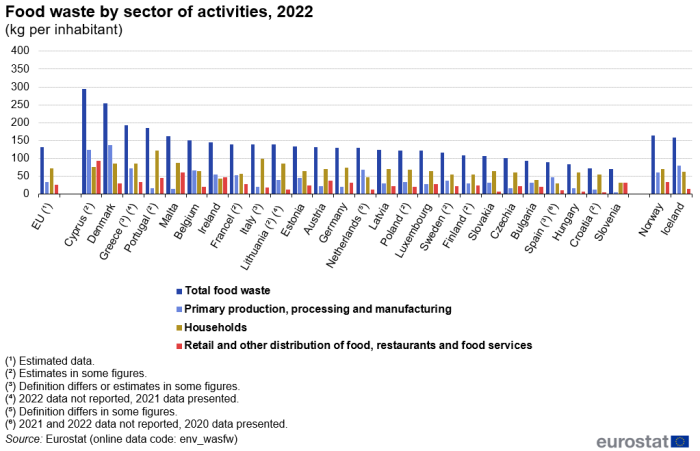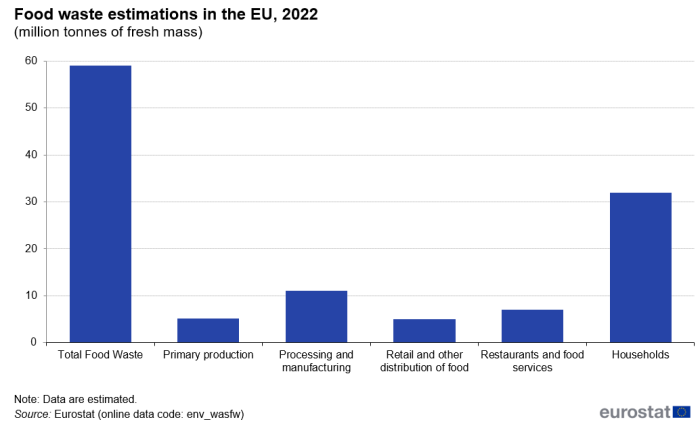Food waste and food waste prevention - estimates
Data extracted in September 2024
Planned article update: September 2025
Highlights
Food waste: 132 kg per inhabitant in the EU in 2022.
This article provides the results of the third reporting obligation of the amount of food waste in the European Union by sector of activity according to the NACE rev.2 classification and by households, excluding food losses (food not harvested or food not authorised to be marketed for safety reasons), for the year 2022.
In 2022 around 132 kg of food waste per inhabitant were generated in the EU. Households generated 54% of food waste, accounting for 72 kg per inhabitant. The remaining 46% was waste generated upwards in the food supply chain. Household food waste is slightly more than twice the amount of food waste arising from the sectors of primary production and manufacture of food products and beverages (10 kg and 25 kg per inhabitant; 8% and 19%, respectively), sectors in which strategies exist for reducing food waste, for instance with the use of discarded parts as by-products. Finally, the sectors restaurants and food services and retail and other distribution of food accounted for 15 kg and 11 kg of food waste per person (11% and 8%, respectively); however, the impact of the end of the COVID-19 lockdowns on these two sectors is still being analysed.
Full article
Amounts of food waste at EU level
At EU level, the total food waste measured in 2022 was slightly more than 59 million tonnes of fresh mass. Household food waste represented 32 million tonnes of fresh mass, with a 54% share of the total. The second sector in terms of share (19%) was processing and manufacturing, where the amount of measured food waste was slightly more than 11 million tonnes of fresh mass. The remaining share, slightly more than a quarter of the total food waste, was from primary production sector (below 5 million tonnes, 8% share towards the total amount of food waste), restaurants and food services (below 7 million tonnes, 11% share towards the total) and retail and other distribution of food sectors (slightly below 5 million tonnes, 8% share). These amounts are presented in Figure 1.
Table 1 presents the amounts of food waste declared by the countries for reference year 2022, measured in tonnes of fresh mass, by sector of activities.
Figure 2 summarises, by aggregated sectors, food waste in terms of kilogrammes per inhabitant; as compared with Figure 1 and Table 1. Figure 2 also presents data from the sectors primary production and processing and manufacturing aggregated in a single class; data from sectors retail and other distribution of food and restaurants and food services are also aggregated in a single class. Figure 2 displays, therefore, for each country, the five sectors collapsed into three sectors, presented side by side with the total food waste, all in kilogrammes per inhabitant.

Source: Eurostat (env_wasfw), definitions
In the supply and consumption sectors, food waste generation may represent 10% of food supplied in the EU
Table 2 illustrates that generated food waste may count for 10% of food supplied to EU consumers in the supply and consumption sectors ("Retail and other distribution of food", "Restaurants and food services" and "Households"). To arrive at this assumption, Eurostat has roughly estimated the food placed on the market from the 2022 FAO data on food supply quantity (source: Food Balances Sheet, FAO database) provided in kilogrammes per inhabitant, and compared it with food waste amounts in the supply and consumption sectors.

Source: Eurostat (env_wasfw) and FAO (Food Balances Sheet)
Methodology
EU Member States measure the amount of food waste for all stages of the food supply chain using the methodology set out in Annex III of Commission delegated decision (EU) 2019/1597.
In the context of this data collection, food means any substance or product, whether processed, partially processed or unprocessed, intended to be, or reasonably expected to be ingested by humans. Food waste consists of parts of food intended to be ingested (edible food) and parts of food not intended to be ingested (inedible food). Food waste is any food that has become waste under these conditions:
- it has entered the food supply chain,
- it has then been removed or discarded from the food supply chain or at the final consumption stage,
- it is finally destined to be processed as waste.
In order to ensure comparability, food waste has to be reported as it was in its fresh mass state. In fact, in many countries there are seasonal effects on the measures of weight of food waste, due to the loss of water originally contained in the food by evaporation or drained from the waste bin, especially occurring in summertime or whenever the food waste is not collected on a daily basis. Therefore, food waste data require measurements and estimations as tonnes of fresh mass. The source of these data is the Waste Framework Directive (2008/98/EC), which establishes an annual reporting obligation on measurements of the levels of food waste, on Commission delegated decision (EU) 2019/1597, that defines the common methodology and minimum quality requirements for the uniform measurement of levels of food waste, and finally on Commission implementing decision (EU) 2019/2000, that provides the reporting format.
Annex III (Methodology for the in-depth measurement of food waste) of Commission delegated decision (EU) 2019/1597 foresees the use of one or more of these methodologies, by sector of activity:
- "Direct measurement" and/or "Waste composition analysis": for all sectors of activities
- "Mass balance": for sectors "Primary production", "Processing and manufacturing" and "Retail and other distribution of food"
- "Questionnaires and interviews" and/or "Coefficients and production statistics": for sectors "Primary production" and "Processing and manufacturing"
- "Counting/scanning": for sectors "Retail and other distribution of food" and "Restaurants and food services"
- "Diaries": for sectors "Restaurants and food services" and "Households"
In the third reporting year, Iceland transmitted data for the first time (currently, only data for reference year 2022). Several countries have improved their measurement methodology, with 8 Member States and Norway revising both 2020 and 2021 reference years' data; 4 Member States have not yet transmitted data for reference year 2022: amongst these, one Member State has not reported 2021 data and one Member State never reported any data. Some countries have used estimates or have indicated that for some data points their definitions differ; estimates and differences in definitions are due to limitations in sample size, exclusion of small subsectors or of small companies or activities, incompleteness of sector surveys, suboptimal estimation of coefficients for the fresh mass calculation, misinterpretation of definitions by data reporters, difficulties in attributing the waste measurement in between two or more sectors. An analysis was conducted on the countries that reported all years by calculating the averaged total amount of food waste (in kg per inhabitant), with the result that the three reference years (2020, 2021 and 2022) almost have the same averaged total amount of food waste (131 kg, 132 kg and 132 kg per inhabitant); therefore, the data from the reporting compliant countries are considered stable. Due to lack of information from the missing reporting countries the EU aggregates are rounded up to 100 thousand tonnes of fresh mass, as revisions and first reporting are expected to change the EU aggregates. EU aggregates data for each reference year are calculated, by each sector, as the ratio between the sum of the reported waste amount divided by the total population of the reporting countries in the year, and finally multiplied by the EU population of the year.
Data interpretation
Countries with a population of less than 10 million inhabitants that are net exporters of raw and manufactured food products may show high amounts of food waste, especially in the processing and manufacturing sector. Data are considered stable and several countries have improved the measurement methodology.
Source data for tables and graphs
Data sources
2022 was the third reporting year of the food waste reporting obligation according to Commission delegated decision (EU) 2019/1597. Information and data are based on the Waste Framework Directive (2008/98/EC) that establishes an annual reporting obligation on measurements of the levels of food waste, on Commission delegated decision (EU) 2019/1597, that defines the common methodology and minimum quality requirements for the uniform measurement of levels of food waste, and finally on Commission implementing decision (EU) 2019/2000, that provides the reporting format. Detailed information are available in the Guidance on reporting of data on food waste and food waste prevention according to Commission Implementing Decision (EU) 2019/2000.
Context
Food waste measurement has a key role to play in the strategies for food waste reduction, that have enormous potential for diminishing the resources used along the whole food supply chain. Reducing food waste would help:
- farmers, companies and consumers to save money;
- decrease the environmental impact of food production, transport, processing and consumption.
Given its important environmental and economic impacts, food waste prevention and the need to adopt a more sustainable production and consumption model is a priority area in the EU's Circular Economy Action Plan. The Action Plan called on the Commission to establish a multi-stakeholder platform dedicated to food waste prevention. Established in 2016, the EU Platform on Food Losses and Food Waste has supported the Commission in its work to adopt EU guidelines to facilitate food donations and the use of food no longer intended for human consumption as animal feed. They also develop food waste measurement methodology and undertake work to improve date marking practices.
Direct access to
- Food waste and food waste prevention by NACE Rev. 2 activity - tonnes of fresh mass (env_wasfw)
Database
- Waste, see:
- Waste streams (env_wasst)
- Food waste and food waste prevention by NACE Rev. 2 activity - tonnes of fresh mass (env_wasfw)
Dedicated section
Publications
- All publications on waste issued by Eurostat.
- Energy, transport and environment indicators — 2020 edition
Methodology
Legislation
External links


